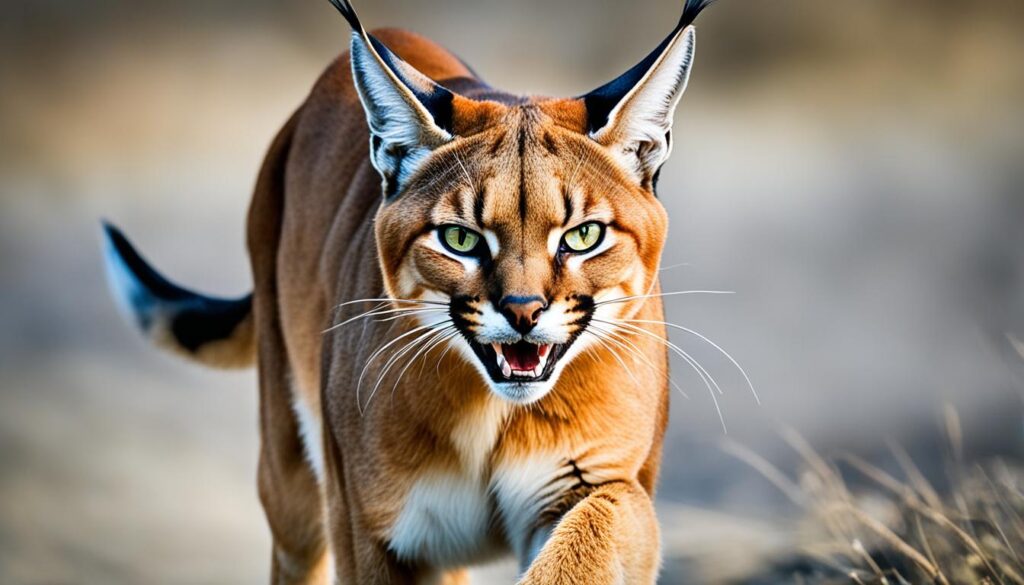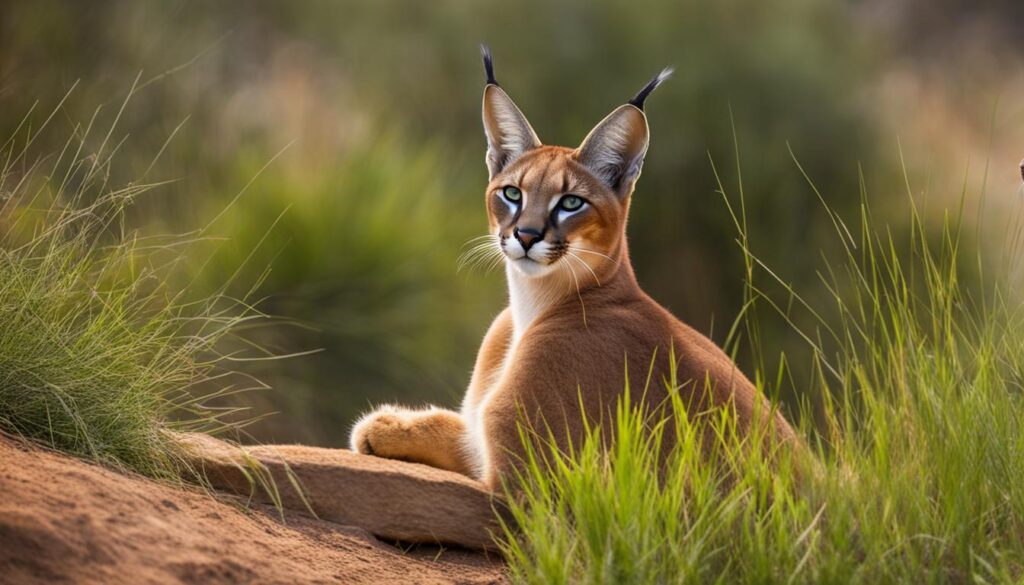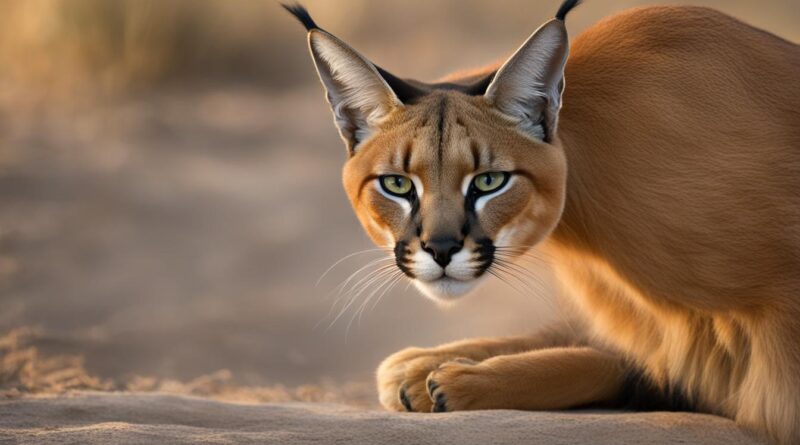Caracal Cats: Are They a Danger to You?
Caracal cats are fascinating creatures known for their exceptional hunting abilities and distinct appearance. Their long and pointy ears give them a striking resemblance to their namesake, the caracal. But when it comes to the safety of humans, are caracal cats dangerous? Let’s explore their behavior and safety concerns to better understand the potential risks associated with owning a caracal cat.
Key Takeaways:
- Caracal cats have impressive physical characteristics and are often mistaken for the serval cat.
- While caracals are not inherently aggressive towards humans, they can pose a threat if they feel threatened or cornered.
- Experts strongly advise against keeping caracals as pets due to their wild nature and specific needs.
- Supporting conservation efforts and visiting wildlife sanctuaries is a responsible alternative to owning caracal cats.
- Ownership of caracal cats as pets varies depending on local laws and regulations.
Fascinating Facts About Caracal Cats
The caracal cat, also known as the “black ears” cat in Turkish, possesses unique characteristics that make it a fascinating species. Often mistaken for the serval cat, caracals exhibit distinctive features that set them apart. Medium in size, these cats measure approximately 1 meter in length and weigh around 18 kg.
One of the most striking physical attributes of caracals is their long and pointy ears, which are always alert. These ears not only contribute to their exceptional hearing ability but also give them a regal appearance. Caracals are renowned for their remarkable jumping and sprinting capabilities, making them agile hunters in the wild.
Caracals primarily feed on a meat-based diet, which includes small mammals, birds, and reptiles. Interestingly, these cats have evolved to survive for extended periods without drinking water, obtaining much of their hydration from their prey.
Caracals are truly fascinating creatures with their distinctive features, agility, and hunting prowess. Let’s delve deeper into the characteristics and behavior of these remarkable cats.
Caracal Cat Characteristics:
| Characteristics | Description |
|---|---|
| Size | Medium-sized cats, measuring approximately 1 meter in length |
| Weight | Average weight of around 18 kg |
| Ears | Long and pointy ears that are constantly alert |
| Hunting Ability | Known for incredible jumping and sprinting abilities |
| Diet | Primarily carnivorous, with a preference for small mammals, birds, and reptiles |
| Hydration | Adapted to survive for longer periods without drinking water |
Are Caracal Cats Dangerous?
While caracals have the genetic makeup and tools to be capable hunters, they are typically not aggressive towards humans. However, like any wild animal, they can pose a threat if they feel threatened or cornered.
Caracals have sharp fangs and retractable claws that they use for hunting and defense.
While caracal attacks on humans are rare, it is still important to exercise caution when interacting with these animals. Understanding caracal behavior and taking appropriate safety measures can help mitigate any potential risks.
If you encounter a caracal in the wild or in a controlled environment, it is crucial to remain calm and avoid making sudden movements. Give the caracal space and do not approach or attempt to touch it. Respect its natural instincts and personal boundaries.
If a caracal displays signs of aggression, such as growling, hissing, or raising its fur, it is a signal that it feels threatened or uncomfortable. In such instances, it is essential to back away slowly and create distance between yourself and the caracal.
It is also important to note that caracals may exhibit territorial behavior, especially in captive settings or when they feel their space is invaded. Adequate enclosures and proper handling protocols should be in place to ensure the safety of both humans and caracals.

Caracal Cats as Pets
Experts strongly advise against keeping caracal cats as pets. Despite their playful nature and ability to form bonds with humans, they are wild animals at heart and have specific needs that cannot be met in a domestic environment. Caracals are territorial, messy, and can exhibit aggressive behaviors. Additionally, they require a specialized diet and may be difficult to find appropriate veterinary care for. It is best to appreciate caracals in their natural habitat rather than attempting to keep them as pets.
| Risks of Owning a Caracal Cat |
|---|
| 1. Aggressive behavior: |
| Caracals have wild instincts that can lead to aggression if they feel threatened or cornered. |
| 2. Territorial nature: |
| Caracals mark their territory and may engage in territorial disputes, which can be challenging to manage in a home environment. |
| 3. Messy habits: |
| Caracals have natural behaviors such as scent marking and scratching, which can result in damage to furniture and property. |
| 4. Specialized diet: |
| Caracals require a diet primarily composed of raw meat, which can be difficult to provide consistently and may not be readily available. |
| 5. Limited veterinary care: |
| Due to their exotic nature, finding veterinarians with expertise in caracal health can be challenging, potentially impacting their overall well-being. |
Trying to keep caracals as pets can put both the owner and the animal at risk. It is important to acknowledge the impracticality and potential dangers associated with owning caracal cats, despite their undeniable beauty and allure.
To truly enjoy these magnificent creatures, it is best to observe them in their natural habitat or support efforts to protect their wild populations through conservation organizations and wildlife sanctuaries. By promoting responsible ownership practices and conservation initiatives, we can ensure a safer and healthier future for these remarkable creatures.
Responsible Ownership and Conservation Efforts
Instead of owning a caracal as a pet, individuals can support conservation efforts aimed at protecting these animals in their natural habitats. Organizations like wildlife sanctuaries and rehabilitation centers work to conserve caracal populations and educate the public about the importance of preserving their natural habitat.
“Conservation is a state of harmony between men and land.” – Aldo Leopold
By visiting these facilities and supporting their initiatives, individuals can contribute to the well-being of caracals and other wildlife. Apart from financial donations, there are various ways to get involved, such as volunteering, spreading awareness, and participating in local community events.
The Importance of Caracal Cat Care
Caracal cat care goes beyond traditional pet ownership responsibilities. While caracals are not suitable as pets due to their specific needs and wild nature, there are still ways to ensure their well-being and conservation:
- Support reputable wildlife conservation organizations and initiatives.
- Stay informed about the latest research and conservation efforts.
- Share knowledge and engage in conversations about caracal conservation.
- Advocate for stricter laws and regulations regarding the ownership and trade of exotic animals.
- Participate in eco-tourism activities that promote responsible wildlife observation.

| Conservation Efforts | Benefits |
|---|---|
| Establishment of wildlife sanctuaries | Provide protected habitats for caracals and other species |
| Rehabilitation centers | Reintroduce rehabilitated caracals into the wild |
| Research and education | Increase knowledge about caracals and their conservation needs |
By prioritizing caracal cat care and supporting conservation efforts, we can ensure that these magnificent creatures continue to thrive in their natural environments for generations to come.
The Role of Legislation
When it comes to owning a caracal cat, the legality of ownership varies depending on the jurisdiction. While some states or regions may allow individuals to own wild animals with the proper permits, many places prohibit keeping caracals as pets due to the risks involved. It is crucial for prospective owners to research and understand the laws and regulations in their area before considering owning a caracal or any other exotic animal.
It is also important to note that even in areas where caracal ownership is permitted, there may still be strict requirements and regulations in place. These may include obtaining specific permits, demonstrating the ability to provide suitable care and housing, and complying with health and safety standards. Violating these regulations can result in legal consequences and harm to both the owner and the animal.
“Responsible ownership of caracal cats requires a deep commitment to understanding and meeting their needs within the confines of the law.”
Considering the unique nature of caracals and their specific care requirements, it is advised to seek alternative ways to support and appreciate these magnificent creatures. Contributing to conservation efforts and visiting reputable wildlife sanctuaries and rehabilitation centers are excellent ways to learn about caracals while promoting their preservation.
By supporting organizations dedicated to the well-being and conservation of caracals, individuals can play an active role in protecting these animals and their natural habitats for future generations. It is through education and conservation efforts that we can truly make a positive impact on the lives of caracals and other wildlife.
The Legal Landscape of Caracal Ownership
| Region | Legality of Caracal Ownership |
|---|---|
| United States | Varies by state. Some states may permit ownership with proper permits, while others prohibit ownership outright. |
| United Kingdom | Illegal to keep as pets without a Dangerous Wild Animals License. |
| Canada | Illegal to own as a pet without a permit. Differs by province. |
| Australia | Generally prohibited. Each state has its own regulations. |
It is crucial to consult local authorities or specialized legal resources to ensure full compliance with specific regulations in your area. Remember, respecting the law is essential for both the welfare of the animals and the well-being of the community.
Conclusion
Caracal cats have captivating qualities that make them intriguing creatures. However, it is important to remember that they are wild animals with specific needs and behaviors. While caracals are not inherently dangerous to humans, it is crucial to respect their natural instincts and temperament.
Instead of considering caracals as pets, individuals can contribute to the conservation efforts aimed at protecting these magnificent felines. By supporting wildlife sanctuaries and rehabilitation centers, we can ensure the well-being of caracals and their preservation in their natural habitat.
Observing caracals in their natural environment allows us to appreciate their beauty and understand the significance of their role in the ecosystem. It also provides valuable educational opportunities for everyone to learn more about their behavior and the importance of their conservation.
FAQ
Are caracal cats dangerous to humans?
Caracal cats are not inherently dangerous to humans, but like any wild animal, they can pose a threat if they feel threatened or cornered. It is important to exercise caution when interacting with these animals.
Can caracal cats be kept as pets?
Experts strongly advise against keeping caracal cats as pets. They are wild animals at heart and have specific needs that cannot be met in a domestic environment.
What are the risks of owning a caracal cat?
Risks of owning a caracal cat include their territorial and potentially aggressive behavior, their specialized dietary requirements, and the difficulty of finding appropriate veterinary care for them.
How should caracal cats be cared for?
Caracal cats should be appreciated in their natural habitat rather than being kept as pets. Individuals can support conservation efforts and visit wildlife sanctuaries and rehabilitation centers to observe caracals and contribute to their well-being.
What are the laws regarding caracal cat ownership?
The ownership of caracal cats as pets varies depending on the jurisdiction. While some places may allow ownership with proper permits, many prohibit keeping caracals due to the associated risks. It is essential to research and understand the laws and regulations in your area before considering owning a caracal or any other exotic animal.
Are caracal cats aggressive?
Caracal cats can exhibit aggressive behavior, especially if they feel threatened or if their territory is invaded. However, they are typically not aggressive towards humans.
Can caracal cats attack humans?
While caracal attacks on humans are rare, it is important to respect their natural instincts and behavior to avoid any potential risks.
What are some fascinating facts about caracal cats?
Caracal cats are known for their exceptional hunting abilities, distinctive appearance with long and pointy ears, and their incredible jumping and sprinting abilities. They are medium-sized cats, measuring about 1 meter in length and weighing around 18 kg. Caracals primarily feed on a meat-based diet and have evolved to survive for longer periods without drinking water.


